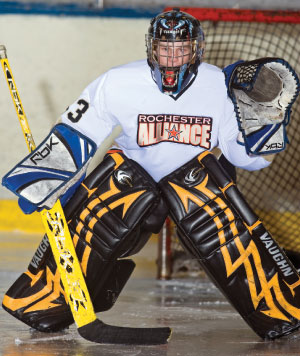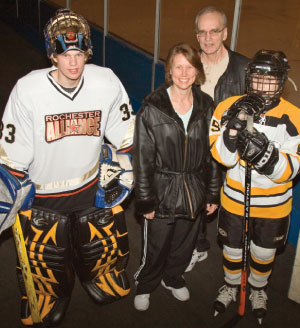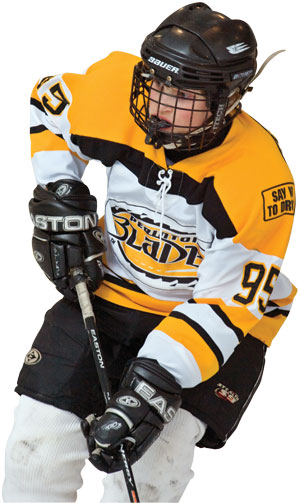Net Gains
By John Clark
Photographs by James Lathrop
How a crazy schedule of school, hockey, and Scouting keeps one family close — even when they're apart.
When Eagle Scout Mike Staversky was 11, he tried out for one of the best youth hockey teams in the region. He played well, too, facing off against two other goalies that were good. But they weren’t as good as Mike.
 Mike Staversky |
Both of the other goalies gave up several goals during the three-night tryouts. Mike didn’t let a single puck get past him. Mike also didn’t make the team. What happened?
Most people faced with that sort of situation would be screaming “Politics!” And most people who heard that rationale would be thinking “Sour grapes!” The Staversky family of Penfield, N.Y., doesn’t take that approach. Trusting that God has a plan, they always expect a more meaningful lesson to emerge from adversity—what they call teachable moments.
Hockey mom Rhonda and her husband, Jack, believed that sort of negative clamor would send the wrong message to their impressionable son. So instead, they gave Mike two choices. “We told Mike that he could either complain about it or work harder and get better,” Rhonda says. “Back away from the challenge or improve.”
Mike accepted that challenge. He worked hard and ramped up his game. Five years later, he plays for the Syracuse Stars junior team, part of a top-notch youth hockey organization in the Northeast—as the starting goalie.
Mike demonstrated a key tenet in his hockey philosophy, which carries over into his life: “You can’t explain the feeling of winning or losing,” he says. “It’s either the greatest feeling or the worst. But you always want to go at them [the opposing team] to get an advantage for your team.”
Keep pursuing those lessons, Mom and Dad might add, and you’ll get an advantage for life.
Frenetic family
If you look for the bottom line in the lives of Scouters Rhonda and Jack Staversky, you won’t find it in their bank account. Look for it on their calendar, where Rhonda keeps close tabs on the family’s frenetic schedule.
 Team Photo: Mike, Rhonda, Jack, and Steven Staversky (from left). |
Mike, now 16, and his Life Scout brother, Steven, 13, learned to ice skate at age 4. They began playing hockey at 7. Both Rhonda and Jack allude to the opposite nature of the boys’ personalities, with each perfectly suited to the positions they play on the ice.
Mike, says Rhonda, has the ideal mentality for a goalie—quiet, observant, doesn’t show his emotions, win or lose. In high-pressure situations, adds goalie coach Dave Wakabayashi, of the Revolutionary Goaltending camp in Canada, “He’ll stop the puck.”
Steven skates for the Rochester Grizzlies of the Perinton Youth Hockey organization. His temperament suits that of a defenseman: outspoken, competitive, and as his dad says, “someone you don’t like to play against because he plays so intensely.” Hockey coach Shawn LaVoy, of Canada's Toronto Hockey Factory clinic describes the kid as “expressing 100 percent energy all the time and [creating] an emotion on the ice to raise the entire team’s performance.”
LaVoy nicknamed Steven “The Hammer,” which kind of says it all.
For the Staversky family, hockey means travel—lots of it. They frequently find themselves waving to one another as they speed off in opposite directions for away games and tournaments in faraway cities such as Cleveland, Pittsburgh, Boston, Toronto, and Ottawa. And because Mike’s home team operates out of Syracuse, 84 miles and a three-hour round-trip from the Staversky home in Penfield, the family logs lots of highway hours to practices, scrimmages, and home games.
All that driving makes a lengthy hockey season (August to March, with tryouts in April) seem longer still. And in summer, the family heads to Toronto and Sudbury in Canada, for…yep, you guessed it…hockey camps.
“We just set the cars on autopilot and go,” Rhonda says with a laugh.
Jack estimates that he and Rhonda put about 20,000 miles a year on the family cars—a Dodge Durango and a Jeep Liberty.
“People hear what we do and tell us we’re crazy,” he says. “They see us wear out our cars and spend so much extra money on gas and hockey equipment. But they don’t know the sport and what you can get out of it as a family.”
You have to wonder, though: How does hockey enrich the family’s life when it keeps them so far apart?
“Actually,” Jack says, “it’s very easy.”
Car talk
To other time-challenged hockey (or fill in the relevant sport here) parents, Jack points out the importance of the grown-ups sharing priorities in terms of the kids and the family.
 Steven Staversky |
“The boys come first. But we’re very intent on raising them into good adults. All the things they do, we believe contribute to that.”
From those activities—sports, Scouting, school, and church, —Mike and Steven have learned much about discipline, patience, time management, prioritizing, and goal setting. The boys earn high marks in school (they’re honor students), work hard to improve their hockey skills, and do what’s needed to maintain their trail of rank advancement in Scouting.
The primary focus areas of their lives have helped teach the boys two of the most important strategies in the Staverskys’ playbook: camaraderie and building community.
“Right!” Jack says. “Look at the road to Eagle Scout. You depend on others all along the way to teach you and guide you and help you achieve rank. In sports, you’re depending on coaches and the other guys on the team to achieve success. And hockey takes perseverance on the part of the teacher and on the part of the boy. Perseverance is also a big part of Scouting.”
Rhonda and Jack persevere, too. In addition to their duties as chauffeurs to hockey events, they volunteer in the Otetiana Council, where Jack has worked at summer camp. Rhonda served as a den leader when the boys were Cub Scouts. She still works as a committee member.
To further support their boys, the Staverskys regularly attend the games—together when they can. On those long automobile rides, they engage in conversation—when Mike and Steven aren’t finishing up homework or listening to their iPods.
“We’ve got a lot of time there,” Rhonda says, “so we’ll talk about God’s purpose for their lives and what’s happening in school or at the rink. Sometimes, we’ll talk about where they want to go to college or if they think they’ll be ready to leave home.”
The example the Staverskys try to set for their kids, Jack says, is that of a family that supports one another.
“We could have a bigger house, newer cars. But we don’t need those things. That’s not what we value. They see a much higher value placed on faith, family, and friendship. They see people trusting each other, taking care of each other, and depending on each other.”
Measured by a traditional gauge of family togetherness, an outsider might judge the Staverskys as not that close. Jack disagrees.
“In the car, we won’t talk the whole time. But sometimes we’ll have an important discussion. And that builds relationships because the boys know that we’re involved and that they can come to us easily. You tell me anyone else who spends as much one-on-one time with their teenage children.”
That’s the bottom line.
John Clark is the senior editor of Scouting magazine.